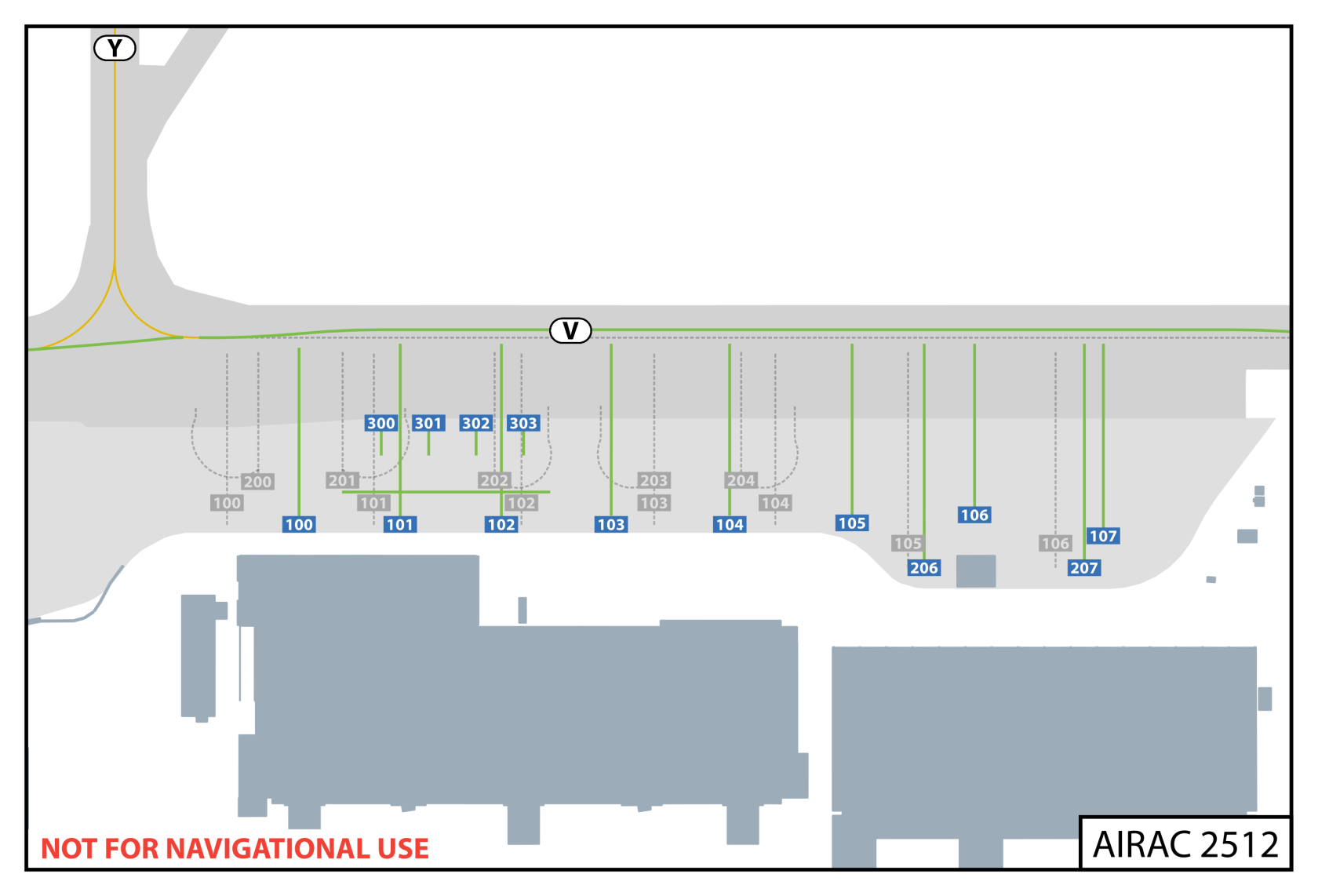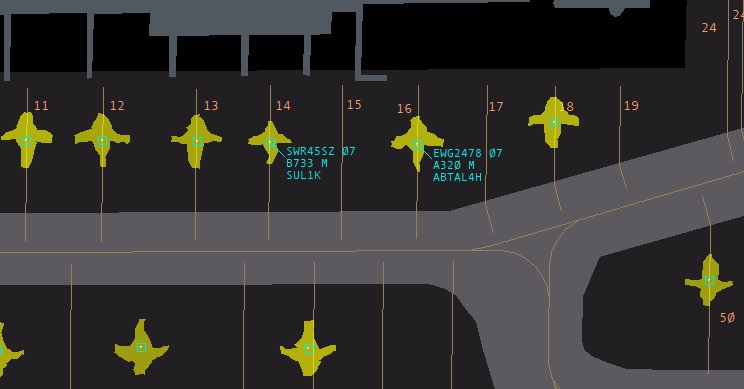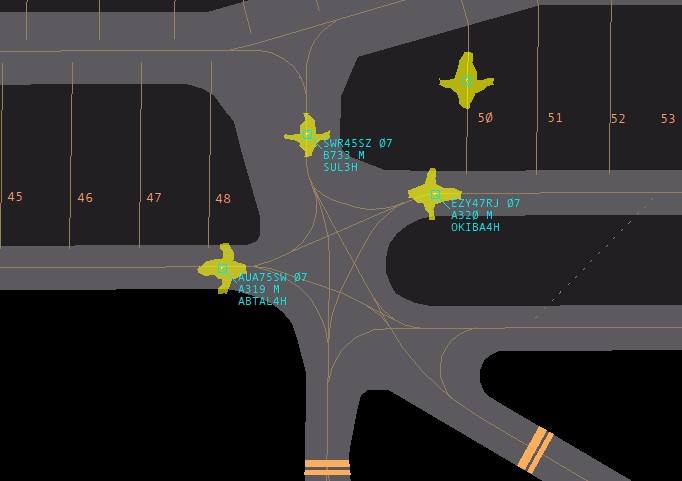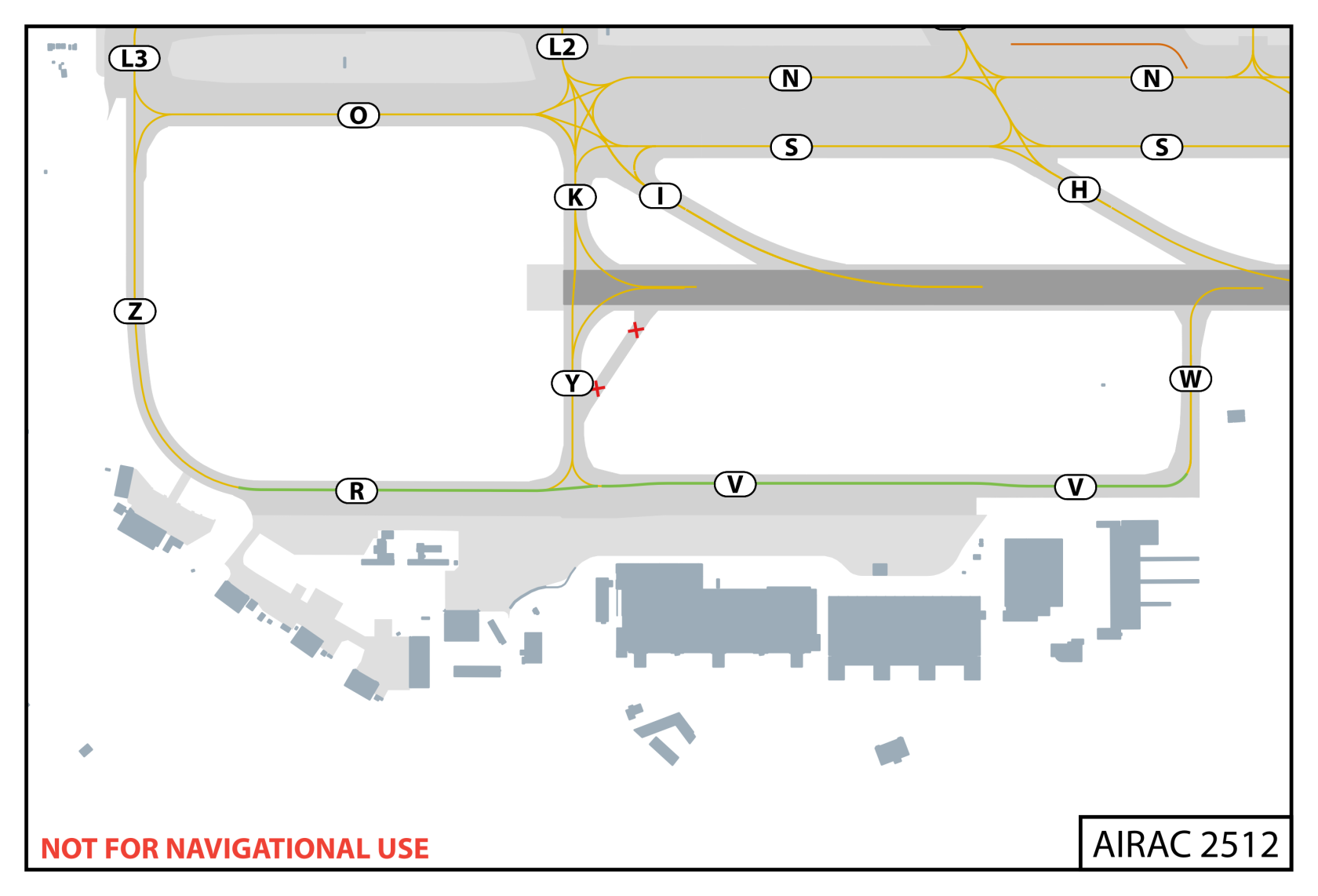Ground
Stuttgart Ground is responsible for all ground movements at the airport (including pushback).
Parking positions
Stands are automatically assigned according to airline and aircraft type. Cargo and US military aircraft (other military aircraft park at an appropriate stand in the North, usually at the GAT if they are small enough) are parked in the Southern part of the airport.
Stands 40 - 56 are taxi out positions, so no pushback is required. Stands 61 - 64 are available for taxi out if the opposite stand is not occupied. If necessary, aircraft may taxi through stands 40 - 56. Only stands 9 - 16 have jetways.
Relocated stands
During construction works, stands 40 - 48 were relocated. This means that, depending on their scenery, pilots might take the wrong stand. The automatic stand assignment is based on the current real world layout.
With AIRAC 2512, parking positions at the South Apron have been reorganized. The apron layout has changed considerably:
- stands 100 - 104 were relocated
- stands 105 - 106 were relocated and renamed to 206 - 207
- stands 200 - 204 with turn-around were replaced by smaller stands 300 - 303 facing north
- stands 105 - 107 were added in between 206 - 207
Consequently, sceneries no longer correspond to the current charts. Only stands 100 - 104 and 206 - 207 will be assigned, once the pilots have been informed of the changes.

New South Apron Layout (green - new layout; grey - old layout)
Pushback
Distance between simultaneous pushbacks
At least two stands have to be between two simultaneously pushing aircraft. This can be reduced to one or even no stand by issuing special pushback instructions. The following example will explains these special pushback instructions.
 SWR45SZ and EWG2478 have both requested pushback but there is only one stand between them
SWR45SZ and EWG2478 have both requested pushback but there is only one stand between them
Assuming both aircraft shall push back facing east, the following pushback instructions will allow for simultaneous pushback.
| if SWR45SZ pushes first |
SWR45SZ is instructed to make a long pushback once SWR45SZ is aligned with the taxiway, EWG2478 is instructed to make a normal pushback |
| if EWG2478 pushes first |
EWG2478 is instructed to make a short pushback once EWG2478 has finished pushing back, SWR45SZ is instructed to make a normal pushback |
If there is no stand between the two aircraft, a simultaneous pushback is only possible with the scenario in which SWR45SZ pushes first; EWG2478 then has to also make a short pushback.
Orange line
The orange line at stands 71-75 allows pushback of aircraft with a maximum wingspan of 36m to allow simultaneous taxi operations of aircraft with a maximum wingspan of 36m on N. For pushbacks on this orange line, there are mandatory pushback directions according to the table below (pushbacks onto N can still face both directions).
- 71 and 72: facing west
- 73: facing west or east
- 74 and 75: facing east
When stands 71A or 74A are occupied, the orange line is not available for pushbacks. Additionally, orange line pushbacks are not available for stands 71A and 74A.
Taxi
Taxiway N is always used opposite to the direction of the active runway. In 25 configuration, N is therefore used for departing traffic, in 07 configuration for arriving traffic. Taxiway S is always used opposite to N.
General Aviation aircraft are usually sent to intersection C (25 operations) or G (07 operations).
Vacating Traffic
Tower will give the initial turn onto N or S after vacating according to the current standard taxi direction. The handoff will take place thereafter.
Runway Crossing
Runway crossings can only be conducted between K and Y. Traffic can either be sent to Tower for the crossing or remain on Ground frequency, depending on the traffic situation (during high traffic, it may be easier to send the aircraft to Tower for a more efficient crossing).
If the aircraft remains on Ground frequency, Tower has to release the crossing and Ground has to inform Tower once the runway is clear again. The following communication helps to keep Tower informed on the status of the crossing.
Traffic is cleared to cross:
Traffic is clear of the runway:
Ground (to Tower): Crossing in progress.
Ground (to Tower): Crossing complete.
Taxiway Z
Taxiway Z west of taxiway Y should only be used for military aircraft. Depending on the amount of traffic, deviations are possible. The extended centerline may only be crossed on Z under the following circumstances:
| 07 operations |
crossings always have to be released by Tower |
| 25 operations (CAT I) |
aircraft < 14m height (all Light and Medium aircraft): Tower informed about crossing aircraft ≥ 14m height: crossing released by Tower |
| 25 operations (LVP) |
aircraft < 6m height (most smaller business jets): Tower informed about crossing aircraft ≥ 6m height: crossing released by Tower |
With AIRAC 2512, taxiway Z has been divided and partially renamed to taxiways R and V. Sceneries no longer correspond to the current charts.
Large aircraft (wingspan larger than B748)
Due to wingspan restrictions on most parts of the Northern apron, special taxi procedures are necessary for aircraft with a wingspan larger than B748 (above 68.5m). These aircraft may not use TWY N between TWYs F and D.
During 07 operations, outbound traffic can simply depart via intersection K or Y, but inbound traffic requires a special routing via S. Due to wingspan restrictions on other exits, these aircraft will have to vacate via B or A. They can't turn immediately onto S from those intersections, but instead need to first taxi via N and then switch to S at D.
During 25 operations, outbound traffic has to taxi via S, opposite to the standard direction and switch to N at D. This means that inbound traffic can't be sent left onto S by Tower - there are multiple possible solutions to this, but the easiest one is for the Tower controller to hand off inbounds holding short of S if there could be a conflict.
The handling of an inbound code F aircraft during 25 operations depends on the current traffic. During periods of low traffic, the aircraft can be allowed to vacate the runway via Y, but during periods of high traffic it might make more sense to instruct the aircraft to vacate to the right via F or H and later cross the runway at K.
Cargo Traffic
Cargo traffic should primary taxi to the cargo positions via Y. Inbounds from runway 25 can vacate via W (depending on wingspan) or Y, while inbounds from runway 07 need to taxi via N or S and K to cross runway 07. During high traffic 07 operations, a crossing on Z might be more efficient.
Ground Movement Strategies
While the best strategy always depends on the individual situation, the following paragraphs give an overview over the most useful strategies which are also regularly used in the real world.
Roundabout
During 07 operations, inbound traffic usually switches from N to M via H, so that L2 and L3 can be used for outbound traffic. Whether traffic pushing back from stands 9-19 should push back facing east- or westbound depends highly on the traffic situation. However, during high traffic situations it usually makes more sense make all pushbacks facing west to keep all traffic on M moving in the same direction.

CFG228G (inbound for stand 14) is instructed to taxi via H and M, while EWG2478 (outbound from stand 16) taxis via L2 and K
As the apron can get crowded really quickly during 07 operations, it can make sense to move outbounds from the Northern apron to the holding point via Z and Y. Keep in mind that crossings on Z always need a release from Tower during 07 operations!
During 25 operations, outbound traffic often switches from M to N via H so that L2 and L3 can be used for inbounds. If there is a lot of outbound traffic, it might make sense to also use L2 for outbounds; keep in mind that you will then have to merge the traffic streams again at H, though.
Outbound Sequencing at K
During high outbound traffic situations with 07 operations, it is good practice to only send aircraft through to the holding point once they have reported ready for departure. A good strategy for ensuring this is to instruct aircraft to hold short of K (if coming from O, N, or S) or of N (if coming from L2). Then, once a pilot has reported ready, they are instructed to continue to the holding point and to contact Tower.
ATC: EZY47RJ, taxi via N, hold short of K, report ready for departure.
Pilot: Taxi via N, hold short of K, wilco, EZY47RJ.
 three aircraft holding short of K/N
three aircraft holding short of K/N
Pilot: SWR45SZ, ready for departure.
ATC: SWR45SZ, taxi to holding point runway 07 via K and contact Tower 118.805.
Pilot: SWR45SZ, taxi to holding point runway 07 via K and contacting Tower 118.805.SWR45SZ taxis forward to the holding point and switches to Tower.
Pilot: EZY47RJ, also ready for departure.
ATC: EZY47RJ, taxi to holding point runway 07 via K and contact Tower 118.805.
Pilot: Taxi to holding point runway 07 via K and contact Tower 118.805, EZY47RJ.EZY47RJ taxis forward to the holding point and switches to Tower.
ATC: AUA75SW, taxi to holding point runway 07 via K and when ready for departure contact Tower on 118.805.
Pilot: AUA75SW, taxiing to holding point runway 07 via K, Tower on 118.805, wilco.
As there are no further aircraft currently taxiing towards the holding point, there is no need to wait for AUA75SW to report ready for departure to Ground once SWR45SZ and EZY47RJ have been moved to the holding point.
De-Icing
Stuttgart has four deicing pads. Deicing operations are only conducted on those deicing pads. Aircraft always have to enter the deicing pad from N. For exiting the deicing pad, the procedures are as follows:
- DP1: westbound via S
- DP2: eastbound via S
- DP3: westbound via S
- DP4: eastbound via S
During 25 operations, it is also possible to allow aircraft that have been deiced on DP2 to make a sharp left turn and join N by crossing H. There are guidance lights for the pilots to follow, but there is no dedicated taxiway. If you want to use this procedure, you should give a very detailed instruction on how to leave the deicing pad in order to make sure pilots understand how the procedure works.
ATC: DLH123, make a left turn, cross taxiway H to join N, thereafter taxi to holding point runway 25 via N and A.
Restrictions
Each deicing pad has a maximum wingspan limit according to the table below.
| Deicing Pad |
Wingspan limit |
| DP1 |
Code E (max. 65 m) except B747 and AN124 (e.g. A359) |
| DP2 |
Code F (max. 80 m) (e.g. A388) |
| DP3 |
Code C (max. 36 m) (e.g. B738) |
| DP4 |
Code C (max. 36 m) (e.g. B738) |
During deicing operations, the relevant sections of taxiway S are closed for taxi operations:
- DP1/DP2: between I and H
- DP3/DP4: between H and F
Additionally, depending on the length of aircraft on the deicing pads, the relevant sections of N have different wingspan restrictions according to the table below.
| Length of aircraft on deicing pad |
Wingspan restriction on N |
| < 50 m (e.g. A310) |
max. 60 m (e.g. B742) |
| 50 - 60 m (e.g. A332) |
Code D (max. 52 m) (e.g. B788) |
| 60 - 65 m (e.g. A339) |
max. 42 m (e.g. B701) |
| 65 - 70 m (e.g. A124) |
Code C (max. 36 m) (e.g. B738) |
| > 70 m (e.g. B748) |
max. 24 m (e.g. CRJ7) |
General Aviation Terminal (GAT)
The GAT itself is uncontrolled. Ground only assigns the GAT exits.
Exit 1 can be used for aircraft with a wingspan up to 22 m while Exits 2 and 3 can be used for aircraft with a wingspan up to 29 m. Multi-engine aircraft and jets shall always use Exit 2 or 3. Aircraft parked at the Southern stands on Apron GA3 can also taxi directly onto N.
Apron GA2 is only available for aircraft with a MTOW of 2000 kg or below (D-Mxxx, D-Exxx and D-Gxxx). Apron GA3 can be used for every aircraft with a maximum wingspan of 29 m and a length of 30.3 m.
During recent real world construction work in the GAT area, the Exits have been renamed and repositioned. While these changes are now complete and the new names are available in the latest charts, most pilots will not have up to date sceneries. Due to this, both Ground ASRs will use the old layout but with updated Exit names.
Keep in mind that some pilots may not be able to use Exit 3 due to their scenery, so it is good practice to ask them if they are able before assigning it.



